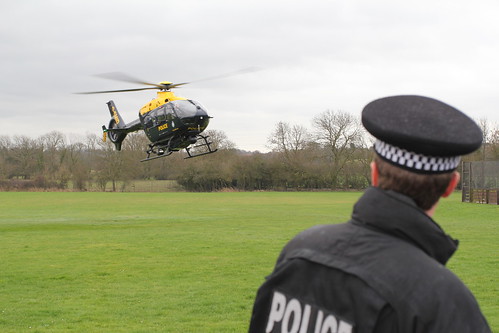Never mind a spot of rain, or the labrador stealing your sandwiches, this could really spoil your day's shooting.
There you are minding your own business, enjoying a bit of peace and quiet in the countryside, watching that flock of pigeons crossing the far side of the field and hoping they'll swing towards your decoys... when a dark blue and yellow helicopter comes low across the hedge.
It swings towards you, and you think "Damn, that's going to put the pigeons off for a bit." It hovers over you, and through the godforsaken racket of the rotor blades, you hear the Voice of God: "Put down your weapon..."
That's the point where you start to get the hump. What the hell? Who do they think they are? Why should I throw my valuable gun in the dirt? I'm not bothering anyone, this is perfectly legal, etc.
All of which are perfectly reasonable things to think... but could get you shot, or at the very least escalate what I've learned is a "low profile stop" into the much more shouty, gunpointy "high profile" version.
I spent Friday at Leicestershire Police HQ, with their Tactical Firearms Unit who - despite appearances - are a very decent, polite bunch of men and women who would like to get on better with the local shooting community. Actually a lot of them are very much part of the local shooting community - PC884 Graham Priestnall, for instance, is a keen shooting man who likes nothing better on his day off than to wander through the fields with his shotgun.
Two years ago, he and his colleagues decided they were spending too much time and taxpayers' money bothering people who were shooting legally, and looked at ways of improving the situation. They came up with the not-so-snappily titled VNSE - Voluntary Notification of Shooting Events.
Bascially, they ask shooters to let them know where and when they plan to go shooting. There's a dedicated telephone number and an email address, and the process takes only a few minutes - just the outline details of name, shooting location, mobile phone number, and the reg no of the vehicle you'll be using. The information goes into a diary which can be accessed by the Operations control staff if need be - if, for example, someone phones in with the classic line "There's a man with a gun, and he's acting a bit suspicious".
It sounds perfectly reasonable and sensible doesn't it. Even more so after I - and around 35 shooters from the Leicestershire area - had gone through a mock training exercise where we were put in the place of the Operations room staff.
We listened to a typical 999 call from a genuinely concerned member of the public, then voted on the best action to take. Then in came another 999 call from the same caller. This time the 'suspicious looking character' was lurking at the back of a school. A check on the now complete reg no of his 'tatty white van' showed it belonged to a man with a history of violence, and previous access to illegal firearms.
Our lecture hall full of dyed-in-the-wool shooters voted as one: send in the Armed Response Unit. I think if there had been a button for the Army, Navy and Air Force, they'd have pressed that one.
And yet... it turned out our man had borrowed his mate's van because his Land Rover was in for service. He was a professional pest controller, doing a spot of work. And since he was nearby, his wife asked if he could pick the kids up after school.
The scenario was carefully designed to show us how difficult it is for the police to get it right; how the information is always incomplete and often misleading; and how they can't just ignore what could turn into a serious threat to the public.
To help push the message home, we were treated to a firepower demonstration at the Tactical Firearms Unit's splendid indoor range, where officers fired their standard weapons - the Glock 9mm pistol, H&K G3 5.56mm carbine, baton rounds and Taser.
Then we went outside to watch their "legitimate shooter" subjected to a "low profile stop" - which is where I began this post.
As I drove back down the M1 through interminable miles of traffic cones and 50mph average speed limits, I turned all this over in my head. Do I think a voluntary notification system is a Good Thing or a Bad Thing?
Well, I'm still in two minds. On one hand, Leicestershire's scheme has led to an 80% reduction in legitimate shooters being subject to the kind of shock-and-awe interruption that we witnessed. It's hard to argue with figures like that. The scheme is operated by people who are fully in favour of shooting sports, and they're doing it for the right reasons. In many ways, it is just a more efficient version of what goes on up and down the country already, with keepers calling their local police to let them know they'll be lamping or deer culling or whatever. (As an aside, the police helicopter pilot pictured above told me whenever he's out in a rural area at night, he can usually see 5 or 6 people out lamping at any one time - he clearly knows what he's looking at, and with the gyro-stabilised TI camera on that thing, he could read your number plate before you even knew he was there!)
And yet, could this be the thin end of the wedge? That concern was clearly on the minds of some in the room. This year it's voluntary, next year it's 'best practice', the year after... well, if you're not going to follow best practice, should we really be renewing your FAC?
That's certainly not what's behind the Leicestershire scheme. Graham and his colleagues set up the scheme for the right reasons, and they're pleased with the results so far. They're keen to listen to shooters' concerns, and improve the scheme where they can. When I tried to explain my "thin end of the wedge" worries, they looked at me somewhat blankly, like they thought I was being a bit paranoid. I, in turn, wondered if they, living in something of a bubble, were being a little naive.
As for the title of this post, what did I learn about how not to get shot? Simple really. Don't act like you might be about to shoot at them.
To a firearms officer, it's all about 'threats', 'compliance' and 'control'. They've been sent out to deal with someone who probably isn't , but might be, a homicidal nutter. That's a threat - to them, and to the public at large.
The helicopter hovering over you can't engage in a detailed conversation about the legalities of pigeon shooting. Neither can the armed officers standing by their vehicles 300 yards away. You can barely hear each other. If you're holding a gun, or they can't see your hands, you're still a threat.
Put the gun down slowly and carefully. You can break it or open the bolt if you wish - just take care not to look like you're pointing it at anyone. Step away from it, and go where you're told, with your arms out so that you're clearly not hiding another gun under your clothing.
They're not going to shoot you for failing to comply with an instruction. But by being cooperative you help them get their job done with the least risk to all concerned - you included. Once they are satisfied that the situation is safe and under control, then you can give them a lecture about your rights to enjoy your sport peacefully. Just remember, they've heard it all before, and like as not they're shooters just like you!









